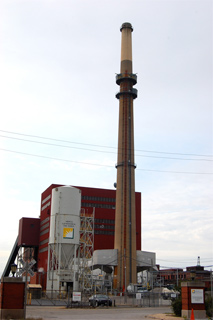New York Times Points to Familiar Foes in Battle to Clean Chicago’s Skies
By JoshMogerman in News on Aug 7, 2010 7:00PM
Three of the most recognizable features on the skyline west of the Loop are the smokestacks from the Fisk and Crawford Generating stations; ancient coal-fired power plants that most agree are blight on the City’s green image. They represent the Chicago's biggest carbon pollution sources and a health threat to this big burgh's populace. But even as a succession of loud voices have called for the plants to clean up or close down, these Teflon polluters remain operating in the places they were built a century ago. What gives them such staying power when similar facilities have been eliminated in so many other American cities? This week the Chicago News Cooperative points a finger at the twin pillars of the city’s political scene---money and the Mayor---but notes out that change could be coming.
The CNC piece by Kari Lydersen (who has covered these plants many times before) runs in locally in the New York Times and starts off with a bang:
Mayor Richard M. Daley has repeatedly billed himself as a green mayor and recently vowed to use “every available tool” to reduce the city’s carbon footprint, but critics say City Hall has failed to grapple with Chicago’s two most significant sources of greenhouse-gas pollution.
The piece goes on to document tens of thousands of dollars in campaign donations from plant owners Midwest Generating LLC going to the state Democratic Party and Republican State Senate Campaign Committee, as well as Aldermen in the wards where the plants sit. But it should be noted that Alderman Munoz of Little Village (home to Crawford) signed on as the 14th co-sponsor for a new ordinance that is once again attempting to clean up or close down Fisk and Crawford.
Joe Moore of the 49th Ward is pushing the Chicago Clean Power Ordinance, which would force the plants into cleaner emissions comparable to natural gas rather than coal. He has gotten the support of a large coalition of over 40 community and national groups (including Greenpeace---how do you think the mayor will react to one of their big stunts?). But, despite backers like Democratic Cook County Board President candidate Toni Preckwinckle, Moore only has half the votes he would need to pass the ordinance, Unless the Mayor signs on, other Alderman likely won’t, meaning that Fisk and Crawford might very well survive this latest challenge---as they did in 2002 when Alderman Burke targeted the plants.
The repeated local attempts to change the plants should not be a surprise. They offer limited value to the City of Chicago, as they employ only a small local work force and export most of the electricity produced out of state. The biggest local impact comes from the soot and noxious gases they pump into the skies over town. NRDC’s Henry Henderson blogged on the Clean Air Act loophole that allows the situation to arise:
…that is how you get a facility like the over 100-year-old Fisk plant sitting in the midst of Chicago's Pilsen neighborhood without the standard equipment to prevent particulate matter and other dangerous pollutants from raining down on the surrounding community. Neighbors complain of the fine dust coating their cars and floors inside their houses ... tragically, its also coating the inside of their lungs.
It has been suggested that Midwest Generation is holding Pilsen and Little Village hostage as a bargaining chip to snare the State in a power supply contract. But, attention from the New York Times and Trib could help more votes materialize for Moore before that deal is even discussed. Or, maybe the attention will end the Mayor's conspicuous silence on what the Washington Post termed as this city’s “Coal Clunkers.”
